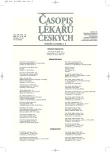-
Medical journals
- Career
Tracheal Intubation without Muscle Relaxant – the Impact of Different Sufentanil Doses on the Quality of Intubating Conditions: A Prospective Study
Authors: M. Adamus 1; J. Koutná 1; T. Gabrhelík 1; J. Zapletalová 2
Authors‘ workplace: Klinika anesteziologie a resuscitace LF UP a FN, Olomouc 1; Ústav lékařské biofyziky LF UP, Olomouc 2
Published in: Čas. Lék. čes. 2008; 147: 96-101
Category: Original Article
Overview
Background.
Following opioid and intravenous anaesthetic, tracheal intubation may be accomplished without any muscle relaxant. In this study, we evaluated the dose requirements for sufentanil with propofol without muscle relaxant administration to obtain clinically acceptable intubation conditions and cardiovascular responses.Methods and Results.
After midazolam (0.05 mg.kg⁻¹), 90 patients were randomized into three equal groups, each receiving sufentanil 0.2 (SUF-0.2), 0.3 (SUF-0.3) or 0.4 (SUF-0.4) μg.kg⁻¹, respectively. Following induction of anaesthesia with propofol (2 mg.kg⁻¹the quality of tracheal intubation was assessed as excellent or good (clinically acceptable) and poor. Excellent intubation conditions were observed in 28 %, 41 % and 54 % of patients in groups SUF-0.2, SUF-0.3 and SUF-0.4, respectively, while poor conditions were present in 31 % (SUF-0.2; p = 0.041 vs. SUF-0.3, p = 0.006 vs SUF-0.4), 7 % (SUF-0.3) and 3 % (SUF-0.4). Patients with induction-related hypotension were older than those without (60 ± 15 vs. 52 ± 17 yr, p = 0.013).Conclusions.
Sufentanil (0.3–0.4 μg.kg⁻¹in combination with propofol (2 mg.kg⁻¹) provided clinically acceptable intubating conditions in 93–97% patients.Key words:
general anaesthesia, endotracheal intubation, propofol, sufentanil.
Sources
1. Scheller, M. S., Zornow, M. H., Saidman, L. J.: Tracheal intubation without the use of muscle relaxants: a technique using propofol and varying doses of alfentanil. Anesth. Analg., 1992, 75, s. 788–793.
2. Stevens, J. B., Vescovo, M. V., Harris, K. C. et al.: Tracheal intubation using alfentanil and no muscle relaxant: is the choice of hypnotic important? Anesth. Analg., 1997, 84, s. 1222–1226.
3. Stevens, J. B., Wheatley, L.: Tracheal intubation in ambulatory surgery patients: using remifentanil and propofol without muscle relaxants. Anesth. Analg., 1998, 86, s. 45–49.
4. Klemola, U. M., Mennander, S., Saarnivaara, L.: Tracheal intubation without the use of muscle relaxants: remifentanil or alfentanil in combination with propofol. Acta Anaesthesiol. Scand., 2000, 44, s. 465–469.
5. Durmus, M., Ender, G., Kadir, B. A. et al.: Remifentanil with thiopental for tracheal intubation without muscle relaxants. Anesth. Analg., 2003, 96, s. 1336–1339.
6. Mallampati, S. R., Gatt, S. P., Gugino, L. D. et al.: A clinical sign to predict difficult tracheal intubation: a prospective study. Can. Anaesth. Soc. J., 1985, 32, s. 429–434.
7. Cormack, R. S., Lehane, J.: Difficult tracheal intubation in obstetrics. Anaesthesia, 1984, 39, s. 1105–1111.
8. Fuchs-Buder, T., Claudius, C., Skovgaard, L. T. et al.: Good clinical research practice in pharmacodynamic studies of neuromuscular blocking agents II: the Stockholm revision. Acta Anaesthesiol. Scand., 2007, 51, s. 789–808.
9. Pollard, R. J., Coyle, J. P., Gilbert, R. L. et al.: Awareness during anaesthesia: a prospective study. Anesthesiology, 2007, 106, s. 269–274.
10. Mertes, P. M., Laxenaire, M. C., Alla, F.: Anaphylactic and anaphylactoid reactions occurring during anesthesia in France in 1999-2000. Anesthesiology, 2003, 99, s. 536–545.
11. Berg, H., Roed, J., Viby-Mogensen, J. et al.: Residual neuromuscular block is a risk factor for postoperative pulmonary complications. A prospective, randomised, and blinded study of postoperative pulmonary complications after atracurium, vecuronium and pancuronium. Acta Anaesthesiol. Scand., 1997, 41, s. 1095–1103.
12. Adamus, M., Gabrhelík, T., Marek, O. et al.: Svalová relaxace na ARO České republiky 2006 – dotazníková studie. Anest. intenziv. Med., 2007, 18, s. 85–90.
13. Mencke, T., Echternach, M., Kleinschmidt, S. et al.: Laryngeal morbidity and quality of tracheal intubation: a randomized controlled trial. Anesthesiology, 2003, 98, s. 1049–1056.
14. Taha, S., Siddik-Sayyid, S., Almeddine, M. et al.: Propofol is superior to thiopental for intubation without muscle relaxants. Can. J. Anesth., 2004, 52, s. 249–253.
15. Woods, A. W., Allam, S.: Tracheal intubation without the use of neuromuscular blocking agents. Br. J. Anaesth., 2005, 94, s. 150–158.
16. Bulow, K., Nielsen, T. G., Lund, J.: The effect of topical lignocaine on intubating conditions after propofol-alfentanil induction. Acta Anaesthesiol. Scand., 1996, 40, s. 752–756.
17. Mulholland, D., Carlisle, R. J. T.: Intubation with propofol augmented with intravenous lignocaine. Anaesthesia, 1991, 46, s. 312–313.
18. Baillard, C., Adnet, F., Borron, S. W. et al.: Tracheal intubation in routine practice with and without muscular relaxation: an observational study. Eur. J. Anaesthesiol., 2005, 22, s. 672–677.
Labels
Addictology Allergology and clinical immunology Angiology Audiology Clinical biochemistry Dermatology & STDs Paediatric gastroenterology Paediatric surgery Paediatric cardiology Paediatric neurology Paediatric ENT Paediatric psychiatry Paediatric rheumatology Diabetology Pharmacy Vascular surgery Pain management Dental Hygienist
Article was published inJournal of Czech Physicians

-
All articles in this issue
- Experience with Early Enteral Nutrition Application in Critically ill Patients in Medical Intensive Care Unit
- Is the Extent of Present Examination of Blood Donors Sufficient? Malignancies in Active Blood Donors
- The Occurrence of Malignancies in Former Blood Donors
- Metabolic Syndrome and Depression – Clinical Relations
- Metabolic Effects of the Endocannabinoid System
- Semen Quality of Pilsner University Students
- Brain Natriuretic Peptide Might Predict the Abnormal Geometry of Heart in Children with Chronic Kidney Disease
- Tracheal Intubation without Muscle Relaxant – the Impact of Different Sufentanil Doses on the Quality of Intubating Conditions: A Prospective Study
- Complications with the Pocket of Cardiostimulator
- Journal of Czech Physicians
- Journal archive
- Current issue
- Online only
- About the journal
Most read in this issue- The Occurrence of Malignancies in Former Blood Donors
- Complications with the Pocket of Cardiostimulator
- Tracheal Intubation without Muscle Relaxant – the Impact of Different Sufentanil Doses on the Quality of Intubating Conditions: A Prospective Study
- Is the Extent of Present Examination of Blood Donors Sufficient? Malignancies in Active Blood Donors
Login#ADS_BOTTOM_SCRIPTS#Forgotten passwordEnter the email address that you registered with. We will send you instructions on how to set a new password.
- Career

